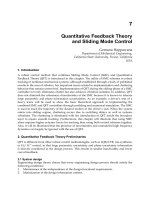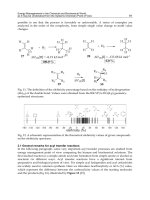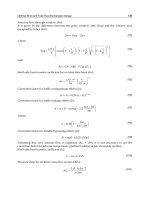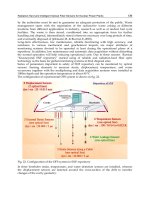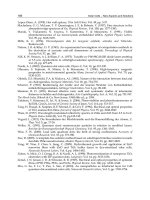Six Sigma Projects and Personal Experiences Part 6 potx
Bạn đang xem bản rút gọn của tài liệu. Xem và tải ngay bản đầy đủ của tài liệu tại đây (557.96 KB, 15 trang )
Six Sigma Projects and Personal Experiences
66
Survey conducted for a COC
A survey of 99 students was the primary source of information for this study. The survey
asked the students to express their thoughts on various aspects of the COC and to indicate
what changes would increase their satisfaction. Customers do not assign equal importance
to all requirements. The survey was administered in two sections. First, the students were
asked to identify the most important consequence, assigning to each a rank from 1 to 10,
with 10 indicating the highest level of importance. The mean rank was calculated for each
customer consequence. To determine the quality of COC services, respondents were also
asked if they would recommend the service to other students. In the second part of the
survey, students were asked to indicate the degree to which each of the consequences was
true of an ideal COC and of the specific university COC on a scale from 1 to 5, where 5
indicated strongly agree and 1 indicated strongly disagree. The mean ratings were
calculated for each consequence as shown in Table 6. The survey results obtained were
analyzed using SERVQUAL by performing a gap analysis that is discussed in the following
section. The questionnaire developed for this study is included in Appendix B.
Customer Requirements
Importance
Ratings
Current
COC
Rating
Ideal
COC
Rating
I have a professional appearance for an
interview
6.8 3.6 4.5
I am comfortable during an interview 7.3 3.5 4.6
I stand out to a potential employer 8.1 3.5 4.7
I am prepared for an interview 7.7 3.5 4.5
I have interviewing experience 6.9 3.5 4.5
I get opportunities with potential employers 7.7 3.5 4.6
I can work overseas 3 2.5 3.7
I know what different jobs are available 7.7 3.5 4.6
I have a professional résumé 7.7 3.6 4.6
I get a résumé evaluation 6.6 3.4 4.5
I have my résumé easily accessible to companies 7.5 3.7 4.6
I get a job that fits me 8.4 3.3 4.7
I get a job that pays well 7.8 3.5 4.6
I have a job that I enjoy 8.4 3.3 4.6
I get job offers 8.5 3.3 4.7
Table 6. Survey Results (Averages of all the ratings)
6.3 Prioritizing SERVQUAL dimensions for a COC
The five SERVQUAL dimensions: reliability, assurance, tangibles, empathy, and
responsiveness were prioritized based on the gap score calculated for each dimension. There
were four items under reliability, three under assurance, two under tangibles, four under
empathy, and two under responsiveness for a COC. For each customer requirement, the
perceived level (P) and expected level (E) of service were obtained from the survey data. The
difference (gap score) between them was calculated, as was the average gap score for each of
Quality Function Deployment in Continuous Improvement
67
the five dimensions. The five RATER dimensions for a COC were prioritized based on the
value of the average gap scores; i.e. the dimension with the highest average gap score was
the one given the highest priority for improvement. Empathy had the highest average gap
score (-1.25), making it the highest priority. The dimensions were prioritized in the
following order starting with the highest priority: reliability (-1.12), responsiveness (-1.1),
and assurance (-1.1), and tangibles (-0.95).
Based on the gap scores calculated for each customer requirement, the importance ratings
obtained from the survey data, and the priority level of each SERVQUAL dimension, the
customer requirements were prioritized. When two consequences have the same gap score,
their mean importance ratings obtained from the survey results could be used to determine
their priority level. The results showed that students identified the following requirements,
listed in priority order from the highest to lowest:
1. I get a job that fits me
2. I have a job that I enjoy
3. I know what different jobs are available
4. I can work overseas
5. I get job offers
6. I get a job that pays well
7. I get opportunities with potential employers
8. I have my resume easily accessible to companies
9. I stand out to a potential employer
10. I am prepared for an interview
11. I am comfortable during an interview
12. I have interviewing experience
13. I get resume evaluation
14. I have a professional resume
15. I have a professional appearance for an interview
6.4 Development of service characteristics for a COC
After analyzing the survey results using SERVQUAL, the focus shifted to the development
of service characteristics that are the design specifications that would satisfy customer
needs. Each customer consequence can have one or more service characteristic. Various
strategies were developed to reduce or eliminate low customer satisfaction and increase the
quality of service. The service characteristics are called the how’s. These characteristics
appear on top of the HOQ and constitute the technical response matrix. They are the
measurable steps to ensure that all customer requirements are met. The service
characteristics defined in QFD are within the organization’s direct control. These
characteristics focus on specific, measurable aspects of service.
Brainstorming was used to develop the service characteristics using various Internet sources
which provided references to industry standards. Tree diagrams were used to organize
these service characteristics. Tree diagrams are hierarchical structures of ideas built from the
top down using logic and analytical thought. A customer design matrix log was then
developed to create a service process development log that provided a history of the
development process. This log contained the design concepts derived from the VOC, along
with the corresponding service characteristics and their values. Twenty service
characteristics were developed which are listed in Appendix C.
Six Sigma Projects and Personal Experiences
68
Dimension No. Customer
Requirements
Expectation
Score (E)
Perception
Score (P)
Gap
Score
(P-E)
Average
for
Dimension
Tangibles 1 I have a
professional
appearance for
an interview
4.5 3.6 -0.9 -0.95
2 I have a
professional
resume
4.6 3.6 -1.0
Reliability 3 I get
opportunities
with potential
employers
4.6 3.5 -1.1 -1.12
4 I have my
resume easily
accessible to
companies
4.6 3.7 -0.9
5 I get a job that
pays well
4.6 3.5 -1.1
6 I get job offers 4.7 3.3 -1.4
Responsiveness 7 I get a resume
evaluation
4.5 3.4 -1.1 -1.1
8 I have
interviewing
experience
4.6 3.5 -1.1
Assurance 9 I am
comfortable
during an
interview
4.6 3.5 -1.1 -1.1
10 I stand out to a
potential
employer
4.7 3.5 -1.2
11 I am prepared
for an
interview
4.5 3.5 -1.0
Empathy 12 I can work
overseas
3.7 2.5 -1.2 -1.25
Table 7. Calculation of Unweighted SERVQUAL Scores
Quality Function Deployment in Continuous Improvement
69
Dimensions
Priority
Level
Customer
Requirements
Gap
Score
Importance
Rating
Empathy
1
I get a job that fits me
-1.4 8.4
2
I have a job that I enjoy
-1.3 8.4
3
I know what different jobs are
available
-1.1 7.2
4
I can work overseas
-1.2 3
Reliability
5
I get job offers
-1.4 8.5
6
I get a job that pays well
-1.1 7.8
7
I get opportunities with potential
employers
-1.1 7.7
8
I have my resume easily accessible to
companies
-0.9 7.5
Assurance
9
I stand out to a potential employer
-1.2 8.1
10
I am prepared for an interview
-1.0 7.7
11
I am comfortable during an interview
-1.1 7.3
Responsiveness
12
I have interviewing experience
-1.1 6.9
13
I get a resume evaluation
-1.1 6.6
Tangibles
14
I have a professional resume
-1.0 7.7
15
I have a professional appearance for
an interview
-0.9 6.8
Table 8. Prioritizing Customer Requirements
6.5 Relationship matrix for a COC
Once the customer consequences and the service characteristics were developed, a
relationship matrix was constructed. This matrix defines the correlations between
customer attributes and technical attributes/service characteristics as strong, moderate, or
weak using a 9-3-1 scale. For this scale the following notations are used: Strong (H) = 9,
Six Sigma Projects and Personal Experiences
70
Moderate (M) = 3, and Weak (S) = 1. Each of the fifteen customer consequences was
matched with each of the twenty service characteristics for a COC. The relationship
between them was then determined and placed in the relationship matrix that constitutes
the center of the HOQ. This matrix identifies the technical requirements that satisfy most
customer consequences and determines the appropriate investment of resources for each.
The technical requirements that addressed the most customer consequences should be
addressed in the design process to ensure a product that satisfies the stated customer
expectations. Ideally in the QFD analysis, no more than 50% of the relationship matrix
should be filled, and a random pattern should result (Fisher and Schutta, 2003).
Relationships were determined here on the basis of research conducted using resources
available on the Internet. Appendix C displays the relationship matrix developed as a part
of the HOQ for a COC.
6.6 Planning matrix (customer competitive analysis) for a COC
After completion of the relationship matrix, the focus of this study shifted to the
construction of the planning matrix, which defines how each customer consequence has
been addressed by the competition. This matrix provides market data, facilitates strategic
goal setting for the new service, and permits prioritization of customer desires and needs. In
this methodology, where we incorporated SERVQUAL into the HOQ, the competitive
analysis is done between the current COC and an ideal COC. For the competitive analysis, a
survey was conducted to determine the characteristics of an ideal COC, and this ideal COC
was compared to a university COC. The survey respondents judged the ideal COC and the
current COC against each of the fifteen consequences on a scale of 1 to 5, where ‘5’ indicated
strongly agree and ‘1’ indicated strongly disagree. The mean for each consequence was
calculated and placed in the columns to the right of the HOQ. A triangle was used for the
ideal COC, and a square was used for a university COC. Appendix C shows the planning
matrix in the HOQ.
6.7 Technical correlations matrix for a COC
Next, the technical correlations were determined after the completion of the planning
matrix. These form the roof of the HOQ. The roof maps the relationships
and interdependencies among the service characteristics. The analysis of these
characteristics informs the development process, revealing the existence and nature of
service design bottlenecks for a COC. The relationships among service characteristics
were plotted and given a value. Past experience and test data were used to complete the
roof of the HOQ. Appendix C shows the correlations developed for the roof of the HOQ
for a COC.
6.8 Technical matrix for a COC
A technical matrix was constructed to form the foundation of the HOQ. This matrix
addresses the direction of improvement, target values, the final weights of service and
quality characteristics, and the level of difficulty to reach the target values. The direction of
improvement indicates the type of action needed to ensure that the service characteristics
are sufficient to make the service competitive; this direction is typically indicated below the
roof of the HOQ.
Quality Function Deployment in Continuous Improvement
71
Dimension No.
Customer
Requirements
Service Requirements
Measuring
Units
Values
Tangibles
1
I have a
professional
appearance for an
interview
No. of workshops
conducted on
professionalism
Number
Integer
value
No. of formal outfits that
could be rented
Number
Integer
value
2
I have a
professional resume
No. of workshops
conducted on resume
and cover letter writing
Number
Integer
value
Reliability
3
I get opportunities
with potential
employers
No. of career fairs held Number
Integer
value
No. of companies
participating in the
career fairs
Number
Integer
value
Number of companies
invited to hold seminars
Number
Integer
value
Number of alumni
invited to be connected
to the university
Percentage Percentage
4
I have my resume
easily accessible to
companies
Provide companies with
online access to resumes
of all students
Boolean
value
Yes/No
5
I get a job that pays
well
Expected salary amount
Money Dollars
6 I get job offers
No. of interview calls
received
Number
Integer
value
Responsiveness
7
I get a resume
evaluation
No. of staff members
appointed for resume
evaluation
Number
Integer
value
Waiting time to get an
appointment for resume
evaluation
Time Days
8
I have interviewing
experience
No. of mock interviews
conducted
Number
Integer
value
Table 9. Customer Design Matrix
Six Sigma Projects and Personal Experiences
72
The quality and service characteristics were analyzed and a standard or limit value was
determined for each. These are the industry standard values. These values were established
based on well-informed assumptions, and they are believed to be within reach for a
university COC. The final weight of each service characteristic was calculated by
multiplying the value assigned to its relationship with a specific consequence (9, 3, 1)
multiplied by the importance of that consequence (obtained from the survey results); the
values of all consequences were then added to yield the final weight, that is a
comprehensive measure that indicates the degree to which the specific service characteristic
relates to the customer consequences. These final weights are shown in a row along the
bottom of the HOQ.
The engineering and technical staff that would design the service process evaluates the level
of difficulty involved in achieving each service characteristic. This evaluation becomes the
basis for development of strategic goals for the development of the service process to ensure
customer satisfaction. The level of difficulty involved in reaching the target values for each
service characteristic was determined on a scale of 0 (easy) to 10 (difficult). Thus, the HOQ
was completed for a COC; it is shown in Appendix C. Twenty service characteristics were
developed that would fulfill customer requirements.
6.9 Results and discussion for a COC
With the help of QFD and SERVQUAL methodologies, the SERVQUAL dimensions,
customer consequences/requirements and the service characteristics were prioritized. The
priority order of the five RATER dimensions based on their gap scores were determined as:
Empathy (-1.25) followed by reliability (-1.12), responsiveness (-1.1), and assurance (-1.1),
and tangibles (-0.95). The overall gap score for the five dimensions was -1.1 indicating a
scope for improvement for a COC. A few of the customer requirements that ranked higher
than the others were: I get a job that fits me, I have a job that I enjoy, I know what different
jobs are available, I can work overseas, I get a job that pays well, I get opportunities with
potential employers, etc.
Establishing a team for career guidance and counseling team to provide students with
individual attention and care would increase the performance of the COC. Hosting more
career fairs with the participation of a large number of companies would provide students
with more opportunities to interact with employers and to secure suitable jobs.
Establishment of a resume evaluation team with sufficient staff would increase student
confidence and help them face interviews. Conducting periodic workshops on writing
resumes and cover letters, interviewing, business ethics, and professionalism would
increase student knowledge and improve their professional skills. Conducting frequent
mock interviews would equip students with practical experience that could help them to
perform better in interviews.
The service characteristics were also prioritized that help the design team in development
of better services and reduce the service development costs. The number of mock
interviews conducted received the highest priority along with number of staff appointed
for conducting mock interviews, followed by the number of staff members on the career
guidance and counseling team, the number of interview calls received, the number of staff
members appointed for resume evaluation, the number of workshops conducted on
setting up, and accessing online job accounts. Also important were expected salary
Quality Function Deployment in Continuous Improvement
73
amount, employer access to online resumes, number of workshops on interviewing and
business ethics, the number of international companies participating in the career fair, and
the number of formal outfits that could be rented. A focus on implementing these service
characteristics in order of their priority would improve the function of the COC.
Priority
Level
Service Characteristics Weight/Importance
1, 2 Number of mock interviews conducted 179.8
1, 2 Number of staff appointed for conducting mock interviews 179.8
3
Number of staff members in career
g
uidance and counselin
g
team
171.1
4 Number of interview calls received 157.4
5 Number of staff members appointed for resume evaluation 138.5
6, 7 Number of companies participating in the career fairs 133
6, 7 Number of career fairs held 133
8
Number of workshops conducted on resume and cover letter
writing
85.4
9 Number of workshops conducted on professionalism 83.9
10 Number of companies invited to hold seminars 87.0
11 Waiting time to get an appointment for resume evaluation 75.3
12
Number of workshops conducted on settin
g
up and accessin
g
online job accounts for students
66
13 Expected salary amount 64.1
14
Provide companies with online access to resumes of all
students
61.6
15 Number of job e-mail alerts sent 59.1
16
Number of workshops conducted on interviewin
g
and
business ethics
47.3
17 Number of alumni invited to be connected to university 35.8
18
Number of international companies participatin
g
in the career
fairs
24.6
19 Number of etiquette dinners offered 22.2
20 Number of formal outfits that could be rented 18.6
Table 10. Prioritizing Service Characteristic
Six Sigma Projects and Personal Experiences
74
7. Appendix A – house of quality for HFCV case study
8. Appendix B – survey questionnaire for COC case study
Part A – Questionnaire
Find the benefit of using the Career Opportunities Center in the list below that is most
important to you. Assign it 10 points. Then, assign from 0 to 10 points to the other benefits
to indicate how important they are to you in comparison to the most important one. You
may assign the same number of points to more than one benefit.
_____ I have a professional appearance for an interview
_____ I am comfortable during an interview
_____ I stand out to a potential employer
Quality Function Deployment in Continuous Improvement
75
_____ I am prepared for an interview
_____ I have interviewing experience
_____ I get opportunities with potential employers
_____ I can work overseas
_____ I know what different jobs are available
_____ I have a professional résumé
_____ I get a résumé evaluation
_____ I have my résumé easily accessible to companies
_____ I get a job that fits me
_____ I get a job that pays well
_____ I have a job that I enjoy
_____ I get job offers
Part B - Questionnaire
Please rate how well the university’s Career Opportunities Center delivers each of these
benefits when you use it. Circle the number below that best indicates how well you feel the
university’s COC satisfies each of the benefits. For comparison purposes, please rate your
ideal career center on the same benefits. Use a scale of:
1= Strongly Disagree
2= Disagree
3= Neutral
4= Agree
5= Strongly Agree
COC Ideal COC
I have a professional appearance for an interview 1 2 3 4 5 1 2 3 4 5
I am comfortable during an interview 1 2 3 4 5 1 2 3 4 5
I stand out to a potential employer 1 2 3 4 5 1 2 3 4 5
I am prepared for an interview 1 2 3 4 5 1 2 3 4 5
I have interviewing experience 1 2 3 4 5 1 2 3 4 5
I get opportunities with potential employers 1 2 3 4 5 1 2 3 4 5
I can work overseas 1 2 3 4 5 1 2 3 4 5
I know what different jobs are available 1 2 3 4 5 1 2 3 4 5
I have a professional résumé 1 2 3 4 5 1 2 3 4 5
I get a résumé evaluation 1 2 3 4 5 1 2 3 4 5
I have my résumé easily accessible to companies 1 2 3 4 5 1 2 3 4 5
I get a job that fits me 1 2 3 4 5 1 2 3 4 5
I get a job that pays well 1 2 3 4 5 1 2 3 4 5
I have a job that I enjoy 1 2 3 4 5 1 2 3 4 5
I get job offers 1 2 3 4 5 1 2 3 4 5
Would you recommend this service to your peers? 1 2 3 4 5 1 2 3 4 5
Six Sigma Projects and Personal Experiences
76
9. Appendix C - house of quality for COC case study
10. References
Akao, Yoji, “Quality Function Deployment: Integrating Customer Requirements into
Product Design,” Productivity Press, New York , NY, (1990).
Quality Function Deployment in Continuous Improvement
77
Andronikidis, A., Georgiou, A.C., Gotzamani, K. and Kamvysi, K. (2009), “The Application
of Quality Function Deployment in Service Quality Management.” The TQM
Journal, Vol. 21 No. 4, pp. 319-333.
Baki, B., Basfirinci, C.S., Cilingir, Z. and Murat, I.AR. (2009), “An application of integrating
SERVQUAL and Kano’s model into QFD for logistics services.” Asia Pacific Journal
of Marketing and Logistics, Vol. 21 No.1, pp. 106-126.
Berger, C., Blauth, R., Bolster, C., Burchill, G., DuMouchel, W., Pouliot, F., Richter, R.,
Rubinoff, A., Shen, D., Timko, M. and Walden, D. (1993), ‘‘Kano’s methods for
understanding customer- defined quality’’, The Center for Quality Management
Journal, Vol. 2 No. 4, pp. 3-36.
Busacca, B. and Padula, G. (2005), ‘‘Understanding the relationship between attribute
performance and overall satisfaction: theory, measurement and implications,’’
Marketing Intelligence and Planning, Vol. 23 No. 6, pp. 543-61.
Chan, L.K. and Wu, M.L., “Quality Function Deployment: A Comprehensive Review of Its
Concepts and Methods”.
Chan, C.Y.P., Allan, C.C. and IP, W.C. (2006)," QFD-based Curriculum Planning for
Vocational Education", Transactions from the Eighteenth Symposium on Quality
Function Deployment, pp. 1-2.
Cohen, L., 2007. Quality Function Deployment: How to Make QFD Work For You. R R
Donnelly Harrisonburg in Harrisonburg, Virginia.
Fisher, C. and Schutta, J.T. (2003), Developing New Service- Incorporating the Voice of the
Customer into Strategic Service Development. ASQ Quality Press, Milwaukee,
Wisconsin.
Griffin, Abbie and John R. Hauser, “The voice of the customer,” Massachusetts Institute of
Technology, Cambridge, MA, (1991).
Helper, C. and Mazur, G. (2006), “Finding Customer Delights Using QFD.” Transactions of
the Eighteenth Symposium on QFD, QFD Institute, ISBN 1-889477-18-4.
Hauser, J. and Clausing, D. (1988), “The House of Quality.” Harvard Business Review, Vol.
66, No. 3, pp. 63-74.
Kano, N. Seraku, K., Takahaski, F. and Tsuji, S. (1984), ‘‘Attractive quality and must-be
quality,’’ Hinshitsu Quality, The Journal of The Japanese Society for Quality
Control, Vol. 14 No. 2, pp. 39-48.
Lim, P.C., N.K.H. Tang, and P.M. Jackson. "An innovative framework for healthcare
performance measurement." Managing Service Quality, 2003: 423-433.
Maritan, D. and Panizzolo, R. (2009),“ Identifying business priorities through quality
function deployment.” Marketing Intelligence and planning, Vol. 27 No. 5, pp. 714-
728.
Matzler, K., Hinterhuber, H.H., Bailom, F. and Sauerwein, E. (1996), “How to delight
your customers,’’ Journal of Product and Brand Management, Vol. 5 No. 2, pp.
6-18.
Miguel, P.A.C. and Carnevalli, J.S. (2008), “Benchmarking practices of quality function
deployment: results from a field study.” Benchmarking: An International Journal,
Vol. 15 No. 6, pp. 657-676.
Olewnik, A. and Lewis, K.(2008), “Limitations of the House of Quality to provide
quantitative design information.” International Journal of Quality and Reliability
Management, Vol. 25 No. 2, pp. 125-146.
Six Sigma Projects and Personal Experiences
78
Oliveria, O.J.D., and Ferreira, E.C. (2009),“Adaptation and Application of the SERVQUAL
Scale in Higher Education,” POMS twentieth Annual Conference, May 1-4, 2009,
Orlando, Florida, USA.
Parasuraman, A., Zeithaml, V.A. and Berry, L.L. (1985), “A Conceptual Model of
Service Quality and its Future Research,” Journal of Marketing, Vol. 49 No. 3, pp.
41-50.
Parasuraman, A., Zeithaml, V.A. and Berry L.L. (1988), “SERVQUAL: A Multiple-Item Scale
for Measuring Consumer Perceptions of Service Quality.” Journal of Retailing, Vol.
64 No. 1.
Paryani, K., Masoudi, A. and Cudney, E. (2010), “QFD Application in the Hospitality
Industry: A Hotel Case Study, The Quality Management Journal, Vol. 17 No. 1, pp.
7-28.
Pawitra, T.A. and Tan, K.C. (2003), ‘‘Tourist satisfaction in Singapore- a perspective from
Indonesian tourists,’’ Managing Service Quality, Vol. 13 No. 5, pp. 339-411.
Redfern, R. and Davey, C.L. (2003), ‘‘Supply chain market orientation in new product
development in the UK: a pilot case study’’, Journal of Fashion Marketing and
Management, Vol. 7 No.1, pp. 65-77
Sauerwein, Elmar, Franz Bailom, Kurt Matzler, and Hans Hinterhuber. "The Kano Model:
How to delight your customers." International Working seminar on prodcution
economics, 1996.
Tan, K.C. and Pawitra, T.A. (2001), ‘‘Integrating SERVQUAL and Kano’s model into QFD
for service excellence development,’’ Managing Service Quality, Vol. 11 No. 6, pp.
418-30.
Wu, H-H, AYH Liao, and PC Wang. "Using grey theory in quality function deployment to
analyse dynamic customer requirements." International Journal on advance
manufacturing technology, 2005: 1241–1247.
Zhao, M. and Dholakia, R. (2009), “A multi-attribute model of web site interactivity and
customer satisfaction.” Managing Service Quality, Vol. 19 No. 3, pp. 286-307.
4
Analysing Portfolios of Lean
Six Sigma Projects
Theodore T. Allen
1
, James E. Brady
2
and Jason Schenk
3
1
Ohio State University
2
FAA Small Airplane Directorate
3
DeVivo AST, Inc.
United States
1. Introduction
The widespread acceptance of Six Sigma as a systematic program of process control,
planning, and improvement has led to the creation of many databases describing the
performance of individual projects, timing, and the techniques used. These databases
provide resources for the analysis of quality management practices. Specifically, there are
three levels at which analysis can occur in this context:
Micro level – lowest level dealing with individual tools and statistical methods
Meso level – mid level dealing with groups of individual tools and supervisor level
decision-making about method selection and timing
Macro level – highest level dealing with organization and institutions and related to
overall quality programs and stock performance
Reviewing the literature reveals a large portion concerning macro-level decision-making,
particularly the decision whether to implement a Six Sigma program at a company, e.g., Yu
and Popplewell (1994), Yacout and Hall (1997), Bisgaard and Freiesleben (2000), Yacout and
Gautreau (2000), and Chan and Spedding (2001). Most of this research is based on
individual case studies and anecdotal evidence. A second large grouping of studies deals
with the micro-level, investigating component tools and techniques for green and black belts
(Hoerl 2001a). Little work is published that relates to the meso-level of mid-level managing
and operational decision-making (Linderman, Schroeder, Zaheer, and Choo 2003). The uses
of these databases for these types of investigation are likely being ignored at most
companies for at least two reasons. First, there has traditionally been little assistance from
academics in how to make sense of them. Second, the people with the most statistical
expertise are involved in the individual projects and not in cross project evaluation. Most
managers are not statisticians and need help in making sense of the data now available to
them. The growing database of project related quality improvement activities could be
useful in the empirical study of some important meso-level research and real-world
questions, including determining the health of a given company’s quality system, modeling
Six Sigma, optimizing the selection and ordering of component methods.
According to Juran and Gryna (1980) the activities that assure quality in companies can be
grouped into three processes: quality planning, quality control and quality improvement.
Six Sigma Projects and Personal Experiences
80
Policies, standard practices, and philosophy make up the quality planning of a system. A
good quality system is proactive not reactive. Quality improvement consists of the
systematic and proactive pursuit of improvement opportunities in production processes to
increase the quality levels. Typically, quality improvement activities are conducted in
projects. This proactive and project-based nature distinguishes improvement from quality
control, which is an on-line process that is reactive in nature. In Harry (1994) all things are a
process. A central belief of Six Sigma is that the product is a function of the design and the
manufacturing process which must produce it.
With Juran and Harry in mind, Six Sigma can be viewed as a process and subject to the same
controls and improvement objectives of other processes. Determining what methods to use,
when to transition to different phases of the project, and under what circumstances to
terminate a project could conceivably make the difference between a healthy and profitable
program and a failed one. Against this background, the purpose of this study was to look at
this growing database in a way that could help management better run improvement
projects.
2. Methods
The use of the many databases of project related quality improvement activities could be
useful in the empirical study of some important research questions. As stated earlier,
potential research topics include: the health of a given company’s quality system, modeling
Six Sigma, or the optimality of selection and ordering component methods associated with
Six Sigma. Researchers focus on what they have data and tools for. Martin (1982) pointed
out that the availability of certain types of data might disproportionately influence the
problems investigated and the conclusions drawn. Now, new data sources and the
associated ability to ask and answer new types of questions are more readily available. For
example, “Is my quality system out-of-control?” “Which method would lead to greatest
expected profits in my case?” “Under what circumstances does it make business sense to
terminate a project?” If these kinds of questions can be systematically explored in the Six
Sigma discourse, then important lessons can be learned regarding investment decisions.
This paper discusses two analysis methods designed for meso-level analysis: exponentially
weighted moving average (EWMA) statistical process control (SPC) and regression. Since its
introduction by Shewhart in the 1930s, the control chart has been one of the primary
techniques of Statistical Process Control (Shewhart 1931). Considering how important
individual projects can be and that they require months or even years, the logical subgroup
size is n = 1 project. With only one measurement per subgroup (a project), a subgroup range
can not be calculated. The data is comprised of a small number of non-normal observations.
The exponentially weighted moving-average (EWMA) control chart is typically used with
individual observations Montgomery (2004). The exponentially weighted moving average is
defined as:
1
(1 )
ii i
Zx Z
(1)
The constant λ takes on the values 0 < λ ≤ 1. The process target value or the average of the
preliminary data can be used as the starting value so that
00
Z
(2)
